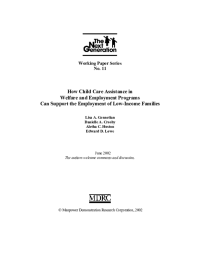How Child Care Assistance in Welfare and Employment Programs Can Support the Employment of Low-Income Families
Summary of Key Findings from Working Paper No. 11
Background
Improving access to affordable, high-quality child care is an important component of efforts to support employment among low-income families. This paper uses data from random assignment studies of 21 welfare and work pilot programs to investigate how a set of child care policies affected low-income families’ use of paid care and subsidies and their experience with employment-related child care problems. In programs that provided it, increased access to care included one or more of the following: promotion and subsidization of formal care, case management and support services, efficient reimbursement of out-of-pocket expenditures, and continuity of care for families transitioning on and off welfare. The effects of programs that increased access to child care are evaluated against the backdrop of child care subsidies provided through the AFDC system and block grants for low-income families available at the time.
Key Findings
- Welfare and work programs generally increased employment and use of paid child care regardless of whether the programs included policies that increased access to care.
- Compared to programs that did not enhance access to child care, those that did increased use of child care subsidies, reduced out-of-pocket costs, and reduced reports of child care problems that interfered with employment.
Conclusions and Implications
Benefits to families from the expanded availability of subsidized child care assistance and lower out-of-pocket cost in welfare and work programs can increase disposable family income, which has been shown to improve child well-being. Reductions in child care problems that interfere with employment, moreover, may promote job stability.






